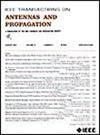Generation of Multichannel Coaxial Quasiperfect Vortex Electromagnetic Waves With Equal Divergence Radii Based on Aperture-Shared Metasurface
IF 5.8
1区 计算机科学
Q1 ENGINEERING, ELECTRICAL & ELECTRONIC
引用次数: 0
Abstract
Vortex electromagnetic (EM) waves hold significant promise for next-generation wireless communication applications. However, their practical deployment is hindered by varying divergence characteristics across vortex modes with different mode numbers. To overcome this challenge and enable true spatial multiplexing of orbital angular momentum (OAM) waves, a dual-polarized shared-aperture metasurface is proposed. By leveraging both polarization and OAM multiplexing, quasiperfect vortex (QPV) EM waves with coaxial beams and equal divergence radii are successfully generated at microwave frequencies. Initially, the properties of QPV waves in the microwave band are analyzed, followed by the design of a dual-polarized metasurface unit. This unit integrates parasitic damping-coupled patches based on the traditional Jerusalem cross structure, providing polarization-independent control and approximately 360° phase-tuning capability. Furthermore, simulations validate the effectiveness of the dual-polarized single-mode metasurface design. Based on this, the concept is extended to a 4-channel multiplexing metasurface, operating at 15 GHz and capable of generating QPV waves. Finally, experimental results from the fabricated metasurface demonstrate the generation of QPV waves with OAM mode numbers 0, +2, +1, and −1, achieving simulated and measured OAM mode purities of 0.835 and 0.70, respectively. The experimental data closely aligns with simulations, confirming the effectiveness of the design. This study offers new insight into generating and applying perfect vortex EM waves, paving the way for high-capacity near-field wireless communication systems and advanced control of novel EM physical dimensions.基于孔径共享超表面的多通道等发散半径同轴准完美涡旋电磁波的产生
涡旋电磁波(EM)在下一代无线通信应用中具有重要的前景。然而,由于不同模态数的旋涡模态的散度特性不同,阻碍了它们的实际应用。为了克服这一挑战,实现轨道角动量(OAM)波的真正空间复用,提出了一种双极化共享孔径超表面。利用极化和OAM复用技术,在微波频率下成功地产生了具有同轴波束和等发散半径的准完美涡旋(QPV)电磁波。首先分析了QPV波在微波波段的特性,然后设计了一个双极化超表面单元。该单元集成了基于传统耶路撒冷十字结构的寄生阻尼耦合贴片,提供与偏振无关的控制和大约360°相位调谐能力。仿真结果验证了双极化单模超表面设计的有效性。在此基础上,该概念扩展到4通道复用超表面,工作频率为15ghz,能够产生QPV波。最后,实验结果表明,制备的超表面产生了OAM模式数为0、+2、+1和−1的QPV波,模拟和测量的OAM模式纯度分别为0.835和0.70。实验数据与仿真结果吻合较好,验证了设计的有效性。该研究为完美涡旋电磁波的产生和应用提供了新的见解,为高容量近场无线通信系统和新型电磁物理尺寸的先进控制铺平了道路。
本文章由计算机程序翻译,如有差异,请以英文原文为准。
求助全文
约1分钟内获得全文
求助全文
来源期刊
CiteScore
10.40
自引率
28.10%
发文量
968
审稿时长
4.7 months
期刊介绍:
IEEE Transactions on Antennas and Propagation includes theoretical and experimental advances in antennas, including design and development, and in the propagation of electromagnetic waves, including scattering, diffraction, and interaction with continuous media; and applications pertaining to antennas and propagation, such as remote sensing, applied optics, and millimeter and submillimeter wave techniques

 求助内容:
求助内容: 应助结果提醒方式:
应助结果提醒方式:


